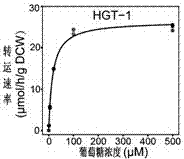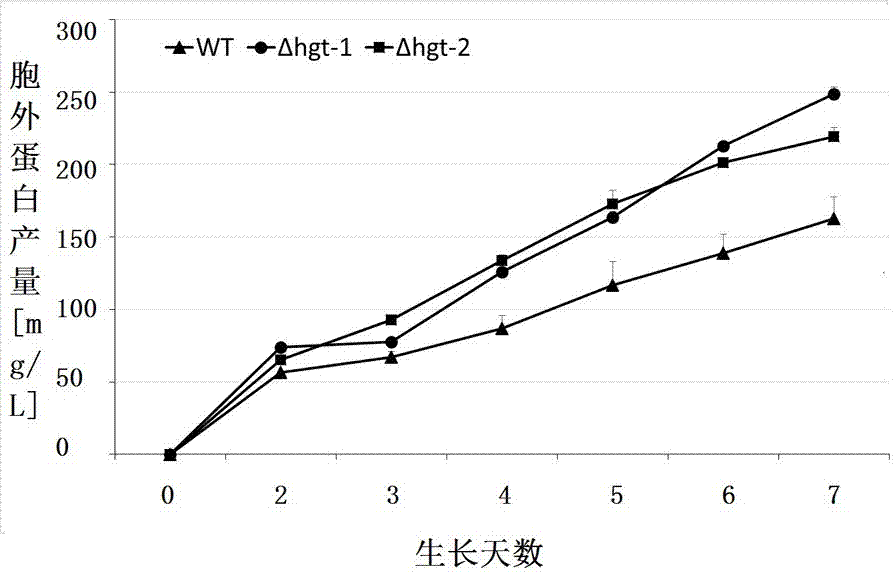Method for improving expression of filamentous fungi lignocellulosic enzyme line and production of bio-based chemicals
A technology of bio-based chemicals and filamentous fungi, applied in the field of genetic engineering, can solve problems such as inability to utilize cellulose
- Summary
- Abstract
- Description
- Claims
- Application Information
AI Technical Summary
Problems solved by technology
Method used
Image
Examples
Embodiment 1
[0131] Example 1 Acquisition of engineered bacteria
[0132] The transporter protein in the starting strain can be knocked out by conventional techniques.
[0133] Taking the originating strain of Neuromonas crassa (FGSC2489) (purchased from FGSC) as an example, according to the principle of homologous recombination, the entire open reading frame (open reading frame, ORF) of NCU10021 was replaced by the hph gene (hygromycin B resistance gene) ).
[0134] 1) Design homology arm-specific primers
[0135] Upstream homology arm-specific primers:
[0136] NCU10021-5f:GTAACGCCAGGGTTTTTCCCAGTCACGACGCCCACCCCAGACCCAGCACT (SEQ ID NO.: 5);
[0137] NCU10021-5r:ATCCACTTAACGTTACTGAAATCTCCAACACATGGTGTTTGTTGTGACTCTTGTGT (SEQ ID NO.: 6)
[0138] Downstream homology arm-specific primers:
[0139] NCU10021-3f:CTCCTTCAATATCATTCTTCTGTCTCCGACAGCTGCATATTTTGAGCTCCTCGTG (SEQ ID NO.: 7);
[0140] NCU10021-3r:GCGGATAACAATTTCACACAGGAAACAGCCGCACACGTCCGCACTTCCT (SEQ ID NO.: 8)
[0141] Amplif...
Embodiment 2
[0152] Example 2 Verification of engineered bacteria
[0153] Genomic DNA extraction: Genomic DNA was extracted from spores by the phenol-chloroform method
[0154] 1) RCR uses a 25 μL system, including 12.5 μL of 12.5 μL DreamTaq PCR Master Mix, 9.5 μL of water (nuclease-free), 1 μL of upstream and downstream primers, and 1 μL of genomic DNA.
[0155] 2) Perform PCR amplification at 95°C for 5 minutes, denaturation at 94°C for 30 seconds, annealing at 52°C for 45 seconds, extension at 72°C for 2 minutes, 34 cycles under the same conditions, and finally annealing at 72°C for 10 minutes.
[0156] 3) 110V voltage, 1% agarose gel electrophoresis for 30 minutes, and the gene amplification bands were viewed under the gel imaging system.
[0157]4) Bacteria preservation: After preservation with 30% glycerin, store in a -80°C refrigerator.
Embodiment 3
[0158] Example 3 Growth of Cellulose and Hemicellulose Yield Assays in Single Gene Knockout Mutants
[0159] Utilize the method of embodiment 1, the identification of embodiment 2, construct following bacterial strain and carry out enzyme production kinetics assay to it:
[0160] Partial base mutation or knockout or weakened transporter gene NCU10021 (HGT-1) constructed with Neurospora as the starting strain;
[0161] Partial base mutation or knockout or attenuation of the transporter gene NCU04963 (HGT-2) constructed from Neurospora (Neurospora) as the starting strain.
[0162] The transporter engineered bacteria and wild-type Neurospora crassa were cultured on 2% crystalline cellulose medium for 7 days, and the supernatant of the medium was collected every day, centrifuged and a series of verification tests were carried out.
[0163] method:
[0164] Total enzyme production assay
[0165] Take 20 μL of supernatant, add 1 mL of Bradford protein chromogenic solution...
PUM
| Property | Measurement | Unit |
|---|---|---|
| affinity | aaaaa | aaaaa |
Abstract
Description
Claims
Application Information
 Login to View More
Login to View More - Generate Ideas
- Intellectual Property
- Life Sciences
- Materials
- Tech Scout
- Unparalleled Data Quality
- Higher Quality Content
- 60% Fewer Hallucinations
Browse by: Latest US Patents, China's latest patents, Technical Efficacy Thesaurus, Application Domain, Technology Topic, Popular Technical Reports.
© 2025 PatSnap. All rights reserved.Legal|Privacy policy|Modern Slavery Act Transparency Statement|Sitemap|About US| Contact US: help@patsnap.com



